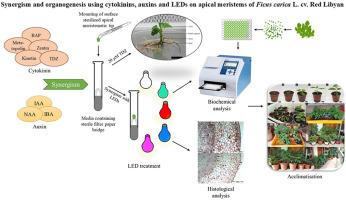细胞分裂素、生长素和发光素对无花果根尖分生组织的协同作用及器官发生。红色的利比亚
IF 3.8
Q2 BIOTECHNOLOGY & APPLIED MICROBIOLOGY
引用次数: 0
摘要
由于其丰富的营养储备,无花果及其增值产品具有重要的商业意义,普通无花果的红利比亚品种(Ficus carica L.)以其鲜红色的果实而闻名。在微繁研究中,器官发生是由于非生物因子与外源和内源植物激素的协同作用。因此,在本研究中,我们旨在研究细胞分裂素、生长素和发光二极管(led)三种非生物探针在生长发育中的协同作用。结果表明,20 μM TDZ处理对提高茎高最有效。根诱导实验表明,含有5 μM IAA的培养基与内源激素协同产生最优根,成功率为62%。细胞分裂素(20 μM TDZ)、生长素(1 μM NAA)和红色LED的协同作用使植株更健康。红+蓝LED组合可获得较高叶绿素和类胡萝卜素浓度的植株。这清楚地表明,由于在激素和光的联合治疗中添加了单个非生物探针,因此具有积极的协同作用。组织学分析揭示了细胞分裂素、生长素和发光二极管协同作用下植株生长的性质和特点。本研究有助于了解植物与激素等非生物探针的相互作用以及LED对微繁实验中器官发生的影响。本文章由计算机程序翻译,如有差异,请以英文原文为准。

Synergism and organogenesis using cytokinins, auxins and LEDs on apical meristems of Ficus carica L. cv. Red Libyan
Owing to their rich nutrient reserves, figs and their value-added products are commercially significant, with the Red Libyan cultivar of common fig (Ficus carica L.) distinguished by its bright red fruit. In micropropagation studies, organogenesis occurs because of the synergistic interaction of abiotic factors with both exogenous and endogenous plant hormones. Therefore, in the present study, we aim to investigate the synergistic interactions among three abiotic probes for growth and development namely, cytokinins, auxins and light emitting diodes (LEDs). Results showed that 20 μM TDZ was the most effective treatment for increasing shoot height. Root induction experiments revealed that media containing 5 μM IAA along with endogenous hormones synergistically produced optimal roots with a 62 % success rate. Synergistic effects of cytokinin (20 μM TDZ), auxin (1 μM NAA) and red LED produced healthier plantlets. Combination of Red + blue LED was optimal to produce plants with higher chlorophyll and carotenoid pigment concentration. This clearly suggests positive synergism due to the addition of a single abiotic probe in the combination treatment of hormones and light. Histological analysis revealed the nature and characteristics of plantlets growing under the synergistic effects of cytokinin, auxin and LEDs. This research contributes to the understanding of plant interactions with abiotic probes such as hormones and impact of LED for organogenesis in micropropagation experiments.
求助全文
通过发布文献求助,成功后即可免费获取论文全文。
去求助
来源期刊

Biocatalysis and agricultural biotechnology
Agricultural and Biological Sciences-Agronomy and Crop Science
CiteScore
7.70
自引率
2.50%
发文量
308
审稿时长
48 days
期刊介绍:
Biocatalysis and Agricultural Biotechnology is the official journal of the International Society of Biocatalysis and Agricultural Biotechnology (ISBAB). The journal publishes high quality articles especially in the science and technology of biocatalysis, bioprocesses, agricultural biotechnology, biomedical biotechnology, and, if appropriate, from other related areas of biotechnology. The journal will publish peer-reviewed basic and applied research papers, authoritative reviews, and feature articles. The scope of the journal encompasses the research, industrial, and commercial aspects of biotechnology, including the areas of: biocatalysis; bioprocesses; food and agriculture; genetic engineering; molecular biology; healthcare and pharmaceuticals; biofuels; genomics; nanotechnology; environment and biodiversity; and bioremediation.
 求助内容:
求助内容: 应助结果提醒方式:
应助结果提醒方式:


